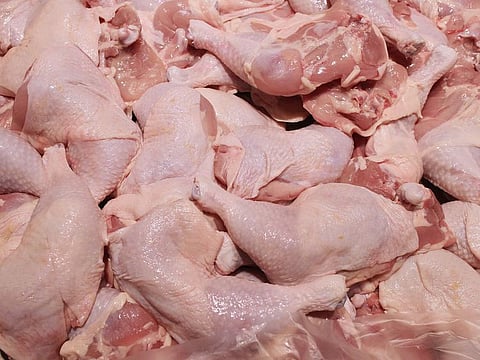Cooking at home: How to make chicken that is safe to eat
How do you avoid giving yourself and your isolation-mates food poisoning?

As we wait out this pandemic, chances are you're at home, cooking. Perhaps you've baked a million loaves of bread and your sourdough starter is overflowing. If Google Trends is any indication of what comes next, after "banana bread" and "pancakes," people are seeking "chicken recipes."
Chicken is one of the world’s most popular meat. But undercooked chicken, when contaminated, is also a leading source of food-borne illness. So how do you avoid giving yourself and your isolation-mates food poisoning?
Many people, including Solveig Langsrud, a scientist at the Norwegian Institute of Food, Fisheries and Aquaculture Research, assume chicken follows a simple rule-of-thumb: Pink chicken turned white means "done." It's similar to how we cook other meats.
"Consumers can see that if you have a hamburger, and it turns from red to brown, it's approximately around the temperature where the meat becomes safe," Langsrud said.
But was this true? Did it line up with temperature recommendations?
As scientific literature offered no clear answer to her questions, Langsrud and her colleagues have identified common problems with recommendations and practices for cooking chicken safely at home. In a study published Wednesday in PLOS ONE, they showed that home cooks often follow intuition and color, disregarding temperature recommendations. Intuition and color sometimes aren't enough to ensure safety. These can be alleviated with a few expert tips.
To study how cooks at home follow safety recommendations, researchers filmed 75 households in five European countries. From a random but nonrepresentative sample, they also conducted an online survey of nearly 4,000 households in the same countries that say they cook chicken.
Worried that chicken would dry out, most home cooks determined doneness by color and texture inside the meat, they found. Few bothered with thermometers, claiming they took too much time, were too complicated to use, didn't fit in the chicken or weren't necessary (although easy-to-use thermometers are inexpensive and widely available).
In additional lab experiments, the scientists injected raw chicken breast fillets with a cocktail of campylobacter and salmonella. These bacteria are common contaminants of chicken and cause millions of sicknesses, thousands of hospitalizations and hundreds of deaths each year in the United States. They cooked the breasts on a commercial grill plate until they reached core temperatures ranging from 50 to 70 degrees Celsius (the World Health Organization's minimum temperature for safe chicken), and they discovered something surprising.
At 158 degrees, but not lower, bacteria inside the chickens' cores was reduced to safe levels, and when cut open its flesh appeared dull and fibrous, not glossy like raw chicken. But meat began changing from pink to white far below this threshold, and most color change occurred below 55 degrees Celsius. Sometimes, the chicken's core would be safely cooked, but unsafe levels of bacteria still lingered on surfaces that hadn't touched the grill plate.
Many people think chicken is safe before it is, Langsrud said. Her advice?
You can check the core for fading pinkness, dulling glossiness and more apparent fibers, all signs of degrading proteins and cooking meat. But those alone won't bring you safety.
You're really better off buying a thermometer. Ask a salesperson how it works and where to measure temperature, said Bruno Goussault, a scientist and chef specializing in precise-temperature cooking at the Culinary Research and Education Academy in Paris and Washington, D.C. Goussault was not involved in the study.
Use it to "follow the temperature," he said, by measuring often. Temperature still increases in the meat's core after it is removed from a heat source. Depending on thickness, a chicken breast's core temperature, for example, may increase 5 degrees Celsius in the 10 minutes after it is removed from heat.
The U.S. Department of Agriculture's Food Safety and Inspection Service's guidelines for cooking chicken at home suggest a minimum core temperature of around 74 degrees Celsius. But using the same recommended temperature for legs and breasts can result in Thanksgiving turkey effect - dry breast and juicy drumsticks - because white meat cooks at lower temperatures than dark.
Americans still should respect these guidelines, Goussault said, but that doesn't mean we must settle for dry chicken. He prefers a sous-vide method that involves vacuum sealing and cooking in a water bath at exact temperatures to consistently arrive at beautiful, juicy and pathogen-free chicken. But you don't need to be a sous-vide master.
Try buying and cooking breasts and legs separately, Goussault said. Bring the breast's core to 165 degrees Fahrenheit, he said, and the leg to between 76 and 78 Celsius.
And remember: Chicken surfaces need love too. Unless the inside of a chicken was contaminated during processing, the outside is where you'll find most bacteria. Boiling it, or searing it uniformly, will ensure heat kills all surface bacteria.
If you really want to safely gauge temperature for a whole chicken, insert a pop-up thermometer into the thickest part of the thigh before roasting it, Goussault suggests. By the time the probe pops, the breasts will have long cooked. They will likely be dry and far from his standards of culinary perfection. But you'll be sure to, as Goussault says in French, "dormir sur ses deux oreilles," or, figuratively, "sleep peacefully."
Sign up for the Daily Briefing
Get the latest news and updates straight to your inbox




